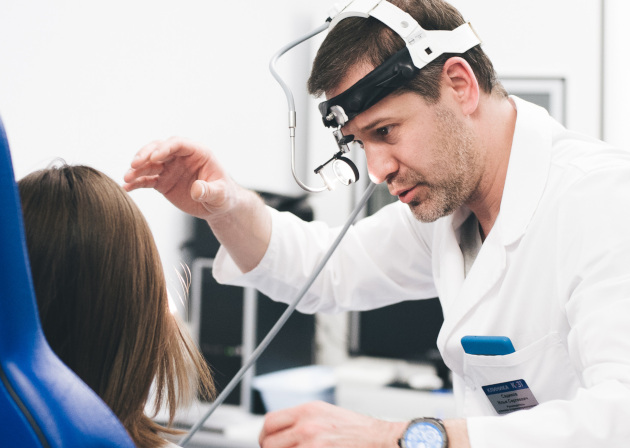Nose fracture

specialists

equipment

treatment
Mechanism of development of nasal trauma

Severe traumatic effects can not only damage the bones of the nose, but also lead to damage to the anatomical structures surrounding it - the sinuses and frontal processes. Injuries affecting the ethmoid bone are especially dangerous, since due to damage to blood vessels they cause heavy bleeding.
Nasal injuries are characterized by the formation of multiple bone fragments, which are usually displaced in different directions, including backwards and sideways. In cases where the impact occurs on the lower part of the nose, isolated cartilage damage occurs.
Main symptoms

After receiving an injury, acute pain occurs, then bleeding begins. Immediately after the impact, swelling forms, which over time spreads to neighboring areas. The skin becomes bluish. When fragments are displaced, a change in the shape of the nose is observed.
In some cases, when the mucous membrane ruptures, subcutaneous emphysema forms. If you try to touch or put pressure on the affected area, the pain intensifies. Due to swelling and changes in the structure of the nasal passages, nasal breathing is impaired. If the injury is accompanied by a concussion, the person becomes weak and becomes very nauseous.
General information
Treatment of a broken nose
Therapeutic approach to nasal fractures
Treatment of a nasal fracture is carried out both on an outpatient basis and in a hospital - it depends on the severity of the injury.
When the bone fragments are not displaced, treatment includes:
- Wound treatment. Antiseptics are used for this - for example, iodine solution, hydrogen peroxide, chlorhexidine. This helps prevent infection and promotes healing
- Use of antibiotics. They are prescribed to prevent bacterial infection. Broad-spectrum drugs are often used - amoxicillin with clavulanic acid or first-generation cephalosporins
In addition, the patient is prescribed physical therapy. In this case, UHF (ultra-high frequency therapy) or magnetic therapy is used. This helps reduce swelling, improve blood circulation and stimulate tissue regeneration processes.
Reposition when bones are displaced
Displacement of bone fragments requires reposition. This procedure is usually performed under local anesthesia on the day you seek medical attention.
Its essence lies in the careful return of displaced fragments of the nasal bones to their anatomically correct position. The procedure is performed manually.
After successful reposition, fixation of the nose is required. In this case, a special splint or patch is used. The length of time the restraints are worn depends on the severity of the injury.
After repositioning, it is recommended to avoid physical activity and blows to the nose. It is also important to follow all recommendations of your doctor and, if necessary, undergo follow-up examinations.
Rhinoplasty
Before rhinoplasty, the surgeon assesses the condition of the patient's nose. Next, he sends him for an examination, which includes:
- Coagulogram
- Electrocardiogram
- Fluorography and MRI of the nose
In addition, the patient is sent for a consultation with an anesthesiologist: surgery after a nasal fracture is performed under general anesthesia. 2 weeks before rhinoplasty, the patient is advised to refrain from smoking, alcohol, fatty foods, and taking certain medications and dietary supplements. You also need to reduce physical activity and try to avoid traumatic situations.
During the operation, the specialist performs an osteotomy - a controlled fracture of the structures of the nasal skeleton. Next, he manually gives the fragments an anatomically correct shape and removes aesthetic imperfections. Then the doctor applies stitches and a fixing bandage. After this, the patient is sent to the ward, where he spends another 1-2 days.
Septoplasty
Septoplasty is aimed at correcting a deviated nasal septum after injury. In addition to the main examination, the victim is given consultations with a cardiologist, otolaryngologist, therapist and anesthesiologist. This is necessary to identify possible contraindications and prepare for surgery.
Septoplasty usually takes from 30 to 90 minutes and is performed under combined anesthesia. Microsurgical equipment is used to minimize tissue trauma. Access to the septum is carried out through the mucous membrane - this eliminates the risk of visible scars. After surgery, special tampons are inserted into the nasal passages to stabilize the shape of the septum.
Rehabilitation after surgery involves following your doctor’s recommendations, regular nose care, and taking prescribed medications. Full recovery occurs within a month after the intervention.

How is an appointment with an otolaryngologist at K+31?
Our doctors

This award is given to clinics with the highest ratings according to user ratings, a large number of requests from this site, and in the absence of critical violations.

This award is given to clinics with the highest ratings according to user ratings. It means that the place is known, loved, and definitely worth visiting.

The ProDoctors portal collected 500 thousand reviews, compiled a rating of doctors based on them and awarded the best. We are proud that our doctors are among those awarded.
Make an appointment at a convenient time on the nearest date
Price
Services





























Main causes and risk factors
People who play contact sports most often experience a broken nose. You can also get injured as a result of a car accident, bad fall or street fight.
In rare cases, a violation of the integrity of the nasal bones is provoked by certain diseases - for example, complicated syphilis and osteoporosis.
The extent of damage to the nasal bones depends on several factors:
If the injury is accompanied by damage to the skin or subcutaneous tissue, such a fracture is called an open fracture. In cases where the skin and subcutaneous tissue remain intact, they speak of a closed fracture.
If bone fragments have moved relative to their original positions, this condition is defined as a displaced fracture. In situations where they maintain their position, a non-displaced injury is diagnosed.